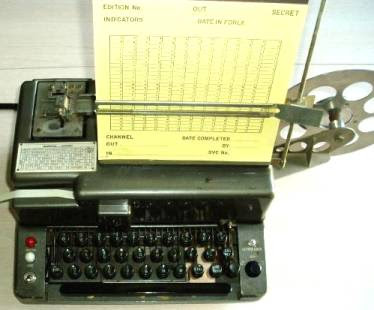 |
| BID-590 NOREEN OTT |
Of course, the OTT method required a complex logistical support to securely distribute large amounts of OTT's. That could only be supported by government departments such as the military, intelligence services and diplomacy. As you can imagine, an enormous amount of OTT's travelled around the world by courier or in diplomatic bags, since you needed as much OTT's as there were message to be send.
 |
| A five bit teletype punched paper tape. Can you read it? |
Although a pretty old system, developed by Gilbert Vernam in 1917, its unbreakable encryption kept it popular until sophisticated electronic crypto machines and modern computer algorithms provided enough security. Nevertheless, some electronic or software one-time key systems still exist for special purposes where absolute secrecy has priority.
Some of the OTT ciphering machines are the American TELEKRYPTON, B-2 PYTHON, SIGTOT and SIGSALY (which used one-time noise), the British BID-590 NOREEN and 5-UCO, the Canadian ROCKEX, the Dutch ECOLEX series, the Swiss Hagelin CD-57, CX-52 and T-55 with superencipherment, the German Siemens T-37-ICA and M-190, the East-German and T-304 LEGUAN, the Czech SD1, the Russian M-100 SMARAGD and M-105 N AGAT, and the Polish T-352/T-353 DUDEK, and of course, the Norwegian ETCRRM, famous from the Washington/Moscow hotline. I'm sure I forgot many more, any suggestions are welcome.
Apart from being unbreakable, OTT systems were quite simple and did not have any secret crypto technology aboard, as mixing one-time keys with plain text is a commonly known basic method of encryption. Whereas other encryption machines were considered as listed secret crypto equipment, OTT devices were mostly unclassified. Only the OTT's themselves were considered secret material. More about one-time pad on my website.
No comments:
Post a Comment